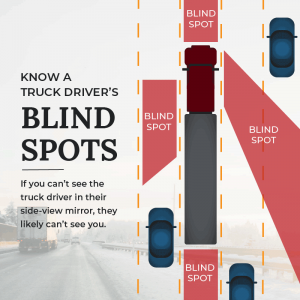Winter Driving Tips – Sharing the Road with Semi-Trucks

As the temperatures continue to drop, it is becoming even more apparent that winter weather is on the way. While winter weather means holidays, bundling up by the fire, and crisp white snow, it also signals dangerous roadways. In particular, winter weather can produce dangerous conditions such as low visibility, icy roads, high winds, and potholes. These conditions can cause accidents, injuries, and even death in some cases. However, semi-trucks are a lesser-known danger on winter roads that can cause just as much damage or more. Due to the size and visibility issues associated with semi-trucks, drivers sharing the road with semi-trucks should exercise extreme caution, especially when winter weather is at play. As an auto accident law firm handling a significant amount of car crash cases on a daily basis, we have a unique understanding of how roadway conditions and weather contribute to the likelihood of a collision. As such, we offer the following winter driving tips in hopes that everyone stays safe this season!
Tips for Driving Sharing the Road with Semi-Trucks
Sharing the road with semi-trucks safely can be difficult when road conditions worsen in the winter. According to the National Traffic Safety Institute, more than 200,0000 collisions occur each year that involve a motor vehicle and a semi-truck. In order to reduce the number of accidents involving semi-trucks in the winter, drivers should adhere to the following recommendations.
1. Watch for a semi’s blind spots
Blind spots are areas to the side of a vehicle that can’t be seen in the rearview or side mirrors. Due to their size, semi-trucks have blind spots that are larger than the average vehicle. Therefore, most often, if you cannot see the truck driver in the semi-truck’s side-view mirror, the semi-truck driver most likely cannot see you. Drivers should be proactive and take this information into account when driving next to a semi-truck driver. Wintry roads make this tip even more important. A trucker that cannot see another vehicle around them may make a sudden decision that doesn’t take the other vehicle into account. Staying in full view of a semi-truck driver helps ensure a driver’s safety.
Below is a helpful graphic showing exactly where a semi-truck’s blind spots are. Keep this in mind this winter when you’re driving around these large vehicles.

2. Avoid “cutting off” a semi-truck driver
Semi-trucks take much longer to slow down or stop in comparison to regular vehicles due to their large size. This is especially true when icy roads are at play. A sudden stop by a semi-truck can cause an accident that may involve multiple cars. Therefore, one of the most important winter driving tips is to avoid immediately switching lanes in front of a semi-truck. Car drivers should also be sure to give a semi-truck enough space when passing. Give semi-trucks at least two car lengths of space behind you and try not to get caught in a situation where you have to slam on the brakes. Slamming on the brakes will not give a semi-truck driver enough time to stop safely and can lead to a multi-car accident.
3. Yield to Semi-Trucks attempting to change lanes
When we’re in a rush and see that a semi-truck is attempting to change lanes, it can be tempting to speed up and pass to avoid getting stuck at a slower pace behind them. Drivers should avoid this temptation, particularly on icy roads. If you attempt to pass the semi-truck and the driver does not see you, he/she may attempt to change lanes anyway, giving you little time to get out of the way.
4. Avoid driving near the axles of a semi-truck
Winter conditions can have a huge effect on tire capacity, particularly in semi-trucks whose tires are under immense weight. A semi-truck’s axles are where the wheels are located on the semi-truck. Driving next to the axles of a semi-truck can be incredibly dangerous in the event of a blown tire. Truck tires are extremely heavy in comparison to normal vehicle tires and can cause damage or accidents to nearby vehicles. When passing a semi-truck, it’s best to get past its tires as quickly and safely as possible.
5. Avoid driving in between semi-trucks
While it can be hard to avoid on multi-lane highways, automobile drivers should do their best to refrain from traveling in a lane between two semi-trucks. This position leaves your vehicle vulnerable to the large blind spots of semi-trucks and gives little opportunity to react in the event that a semi-truck attempts to merge into your lane or is forced into your lane due to dangerous road conditions created in the winter such as black ice and high winds.
6. Watch out for windy roads
Windy roads can create danger for all drivers, especially in the winter when conditions are already slick. Semi-trucks are even more prone to accidents on windy winter roads. Because semi-trucks have a different weight distribution than smaller vehicles, windy conditions can push them into another lane or off the road. Therefore, it is important to exercise even more caution when driving near semi-trucks in windy weather conditions.
Drivers of automobiles can be proactive by maintaining a golden rule of the road: be respectful of other drivers. When drivers take this sentiment into account, along with the above winter driving tips and understanding of the challenges semi-truck drivers face in the winter, roadways can become much safer for all involved. However, even the most cautious driver can find themselves a victim of a semi-truck accident. Semi-truck accidents can result in serious, long-term injuries requiring extensive medical care as well as the expertise of a lawyer well versed in the complicated nuances of semi-truck accidents. Our attorneys have helped many Michigan families recover the compensation and resources they need following a collision with a semi-truck.
RELATED READING:
How Trucking Companies Fight Lawsuits and What to Look for in a Lawyer to Challenge Them

